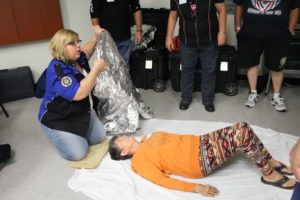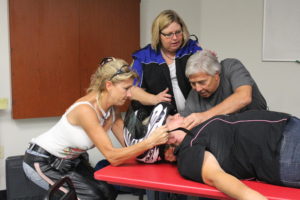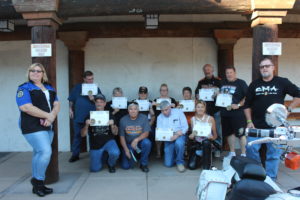T he last thing any of us wants to encounter when out riding is an accident. But what if you not only encountered one, but were one of the first on the scene? Maybe you even witnessed it! Would you know what to do? I did not, so this past weekend “CC Rider†and I attended a class created by Accident Scene Management. The class was called A Crash Course for the Motorcyclist and by the time the class ended, we were quite well-prepared in what to do during the first 5-30 minutes after an accident until professional assistance has arrived on scene.
he last thing any of us wants to encounter when out riding is an accident. But what if you not only encountered one, but were one of the first on the scene? Maybe you even witnessed it! Would you know what to do? I did not, so this past weekend “CC Rider†and I attended a class created by Accident Scene Management. The class was called A Crash Course for the Motorcyclist and by the time the class ended, we were quite well-prepared in what to do during the first 5-30 minutes after an accident until professional assistance has arrived on scene.
The excellent basic course we took, “A Crash Course for the Motorcyclistâ€, was the first of 5 types of courses available.  It is followed by “Basic Refresherâ€, “Advanced Bystander Assistanceâ€, “Anatomy of a Motorcycle Crashâ€, and “Advanced Refresherâ€.
The class was held at Desert Wind Harley-Davidson in Mesa, AZ and we offer many thanks to them for their continuing support of safe motorcycling. During the day, which started at 9 am and ended at roughly 4 pm (with an hour for lunch), we learned the basics, including how to prevent (further) injury to the neck and spine, how to safely move an injured rider and even how to remove a full face helmet (only if necessary, of course).
The course we took was taught by Teresa (Trauma Mama) McClelland and Ben Martinez, both well-known and respected in the Arizona motorcycling community. Teresa is a Trauma Nurse with extensive experience and is an excellent teacher. She is well prepared to answer any and all questions form novices like myself to other EMS professionals (we had several in our class).
Teresa and Ben, as well as their assistants Chris Fagenbush, and Jodi Cicirello, broke the class down into easy to digest component parts under the acronym “PACTâ€:
- Prevent Further Injury
- Assess the Situation
- Contact the EMS
- Treat Injuries
Even the section on treating injuries was broken down into simple first aid steps even I could grasp.
The other aspect of this course that makes it both effective and enjoyable is there’s a lot of hands-on instruction. For example, when we covered how to remove a full-face helmet, everyone was able to practice it from both lead and assisting positions (using a two- man technique) on a live “patient†who could give immediate feedback on how well we did. That was huge! They also came equipped with the best breathing and CPR dummies available so your experience was a real as possible.

Teresa McClelland teaches Accident Scene Management at Desert Wind Harley-Davidson in Mesa, Arizona.
It has been a very long time since I had a basic first-aid course or a CPR course, and many things have changed, so I was extremely glad we decided to take this course. The Certificate of Completion we received at the end of the course is good for 2 years and we will certainly be back for the refresher.
Most of the attendees would be returning the following day for the Advanced Course, but “CC Rider†and I will have to take that at a later date. Signing up is very easy and you may want to give Teresa a call to see if your club or organization offers any discounts on the VERY reasonable cost. Some classes are further subsidized by local businesses such as Breyer Law or groups like ABATE of AZ, so be sure to check.
For more information visit: www. roadguardians.org or contact Teresa McClelland at either 773-450-3698 or tjm911rn@aol.com


